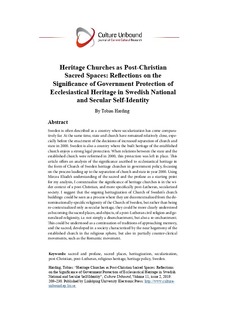| dc.contributor.author | Harding, Tobias | |
| dc.date.accessioned | 2019-11-14T11:38:00Z | |
| dc.date.available | 2019-11-14T11:38:00Z | |
| dc.date.created | 2019-09-25T14:41:24Z | |
| dc.date.issued | 2019 | |
| dc.identifier.citation | Culture Unbound. Journal of Current Cultural Research. 2019, 11 (2), 209-230. | nb_NO |
| dc.identifier.issn | 2000-1525 | |
| dc.identifier.uri | http://hdl.handle.net/11250/2628510 | |
| dc.description | Culture Unbounduses a so called “Attribution Non-commercial” (CC BY-NC) license which allows users to distribute the work and to re-work it without the author's permission, but not for any commercial purposes and never without acknowledging the original author. | nb_NO |
| dc.description.abstract | Sweden is often described as a country where secularization has come comparatively far. At the same time, state and church have remained relatively close, especially before the enactment of the decisions of increased separation of church and state in 2000. Sweden is also a country where the built heritage of the established church enjoys a strong legal protection. When relations between the state and the established church were reformed in 2000, this protection was left in place. This article offers an analysis of the significance ascribed to ecclesiastical heritage in the form of Church of Sweden heritage churches in government policy, focusing on the process leading up to the separation of church and state in year 2000. Using Mircea Eliade’s understanding of the sacred and the profane as a starting point for my analysis, I contextualize the significance of heritage churches is in the wider context of a post-Christian, and more specifically post-Lutheran, secularized society. I suggest that the ongoing heritagization of Church of Sweden’s church buildings could be seen as a process where they are decontextualized from the denominationally-specific religiosity of the Church of Sweden, but rather than being re-contextualized only as secular heritage, they could be more clearly understood as becoming the sacred places, and objects, of a post-Lutheran civil religion and generalized religiosity, i.e. not simply a disenchantment, but also a re-enchantment. This could be understood as a continuation of traditions of approaching memory, and the sacred, developed in a society characterized by the near hegemony of the established church in the religious sphere, but also in partially counter-clerical movements, such as the Romantic movement. | nb_NO |
| dc.language.iso | eng | nb_NO |
| dc.rights | Navngivelse-Ikkekommersiell 4.0 Internasjonal | * |
| dc.rights.uri | http://creativecommons.org/licenses/by-nc/4.0/deed.no | * |
| dc.title | Heritage Churches as Post-Christian Sacred Spaces: Reflections on the Significance of Government Protection of Ecclesiastical Heritage in Swedish National and Secular Self-Identity | nb_NO |
| dc.type | Journal article | nb_NO |
| dc.type | Peer reviewed | nb_NO |
| dc.description.version | publishedVersion | nb_NO |
| dc.rights.holder | (c) 2019 The Author(s) | nb_NO |
| dc.source.pagenumber | 209-230 | nb_NO |
| dc.source.volume | 11 | nb_NO |
| dc.source.journal | Culture Unbound. Journal of Current Cultural Research | nb_NO |
| dc.source.issue | 2 | nb_NO |
| dc.identifier.cristin | 1729007 | |
| cristin.unitcode | 222,59,3,0 | |
| cristin.unitname | Institutt for kultur, religion og samfunnsfag | |
| cristin.ispublished | true | |
| cristin.fulltext | original | |
| cristin.qualitycode | 1 | |

